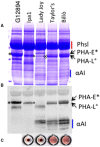Exploitation of Common Bean Flours with Low Antinutrient Content for Making Nutritionally Enhanced Biscuits
- PMID: 27446157
- PMCID: PMC4921496
- DOI: 10.3389/fpls.2016.00928
Exploitation of Common Bean Flours with Low Antinutrient Content for Making Nutritionally Enhanced Biscuits
Abstract
Consumption of legumes is associated with a number of physiological and health benefits. Legume proteins complement very well those of cereals and are often used to produce gluten-free products. However, legume seeds often contain antinutritional compounds, such as phytate, galactooligosaccharides, phenolic compounds, lectins, enzyme inhibitors, whose presence could affect their nutritional value. Screening natural and induced biodiversity for useful traits, followed by breeding, is a way to remove undesirable components. We used the common bean cv. Lady Joy and the lpa1 mutant line, having different seed composition for absence/presence of lectins,α-amylase inhibitor, (α-AI) and phytic acid, to verify the advantage of their use to make biscuits with improved nutritional properties. We showed that use of unprocessed flour from normal beans (Taylor's Horticulture and Billò) must be avoided, since lectin activity is still present after baking, and demonstrated the advantage of using the cv. Lady Joy, lacking active lectins and having active α-AI. To assess the contribution of bean flour to biscuit quality traits, different formulations of composite flours (B12, B14, B22, B24, B29) were used in combinations with wheat (B14), maize (gluten-free B22 and B29), or with both (B12 and B24). These biscuits were nutritionally better than the control, having a better amino acid score, higher fiber amount, lower predicted glycemic index (pGI) and starch content. Replacement of cv. Lady Joy bean flour with that of lpa1, having a 90% reduction of phytic acid and devoid of α-AI, contributed to about a 50% reduction of phytic acid content. We also showed that baking did not fully inactivate α-AI, further contributing to lowering the pGI of the biscuits. Finally, data from a blind taste test using consumers indicated that the B14 biscuit was accepted by consumers and comparable in terms of liking to the control biscuit, although the acceptability of these products decreased with the increase of bean content. The B22 gluten-free biscuits, although received liking scores that were just above the middle point of the hedonic scale, might represent a good compromise between health benefits (absence of gluten and lower pGI), expectations of celiac consumers and likeness.
Keywords: amino acid score; biscuits; consumers test; lectins; nutritional enhancement; phytic acid; predicted glycemic index; α-amylase inhibitor.
Figures




References
-
- Alonso R., Aguirre A., Marzo F. (2000). Effects of extrusion and traditional processing methods on antinutrients and in vitro digestibility of protein and starch in faba and kidney beans. Food Chem. 68, 159–165. 10.1016/S0308-8146(99)00169-7 - DOI
-
- Anton A. A., Fulcher R. G., Arntfield S. D. (2009). Physical and nutritional impact of fortification of corn starch-based extruded snacks with common bean (Phaseolus vulgaris L.) flour: effects of bean addition and extrusion cooking. Food Chem. 113, 989–996. 10.1016/j.foodchem.2008.08.050 - DOI
-
- AOAC (2000). Official Method of Analysis, 7th Edn. Washington, DC: Association of Official Analytical Chemists.
LinkOut - more resources
Full Text Sources
Other Literature Sources

